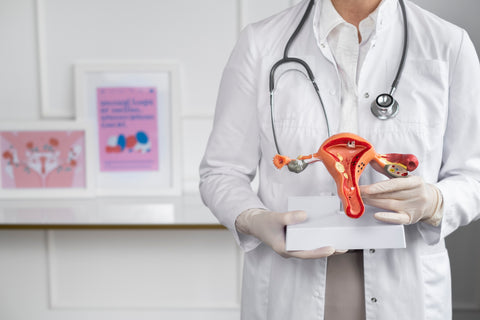7 Reasons Why You Have Ovulation Pain


Ovulation pain, or mittelschmerz, might take the form of spasms or cramping, accompanied by mild vaginal bleeding and discharge, which are the additional signs of ovulation discomfort. Testing and over-the-counter pain relievers usually do the trick. Ovulation happens somewhere in the midst of a woman's menstrual cycle, and ovulation bleeding is defined as vaginal bleeding that occurs at or just before or following ovulation. Moreover, light spotting around ovulation usually does not indicate a significant issue and is mainly caused by fluctuations in oestrogen levels. Ovulation bleeding is also sometimes called oestrogen breakthrough bleeding. Are you experiencing vaginal bleeding? Learn about ovulation bleeding in this post.

Ovulation bleeding occurs whenever an egg is push out from the ovary, wherein the oestrogen levels increase gradually in the days preceding ovulation. When an egg is released, there is a decrease in oestrogen and a rise in progesterone. In this, the menstrual blood is generally a little lighter than in a regular period. This might be a result of the change in the equilibrium between progesterone and oestrogen levels.
In addition, it often manifests itself in only some of the ways. Bleeding that lasts more than several days or is accompanied by other symptoms like cramps suggests that something different than ovulation bleeding might be behind this condition. Those who don't ovulate consistently may have irregular menstrual cycles. This may manifest as either a lack of menstruation for long periods or mild, intermittent flow over several days. Moreover, endometriosis and polycystic ovarian syndrome (PCOS) could result in irregular menstrual periods.
The egg grows in the ovary, and as it develops, follicular fluid encircles it. Hence, during ovulation, the ovary releases an egg, blood, and fluid. Mittelschmerz could occur because the egg enlarges in the ovary just before ovulation. The pain might also be because of a broken follicle. The egg then ruptures from the follicle whenever it is ready, and the burst might result in some bleeding between periods. Moreover, the fluid and the blood from the ruptured follicle might irritate the abdominal lining (peritoneum), which cause pain, a normal occurrence in the menstrual cycle.
In addition, ovulation bleeding could be a result of rapid hormonal fluctuations and increases that occur during ovulation. In one study, greater levels of luteinizing hormone (LH) and luteal progesterone around ovulation were observed in women who suffered from ovulation bleeding. However, having lower or higher levels of these hormones does not imply you are more or less probable to give birth.

The spotting around ovulation is a tell-tale sign that you might be pregnant. Potting refers to abnormal uterine bleeding, mild vaginal discharge that occurs between menstruation. This bleeding is often far less heavy than what you'd encounter with a period. Sometimes the reason for the spotting may be deduced from the blood's hue. This is due to the fact that the rate of blood flow causes a corresponding change in hue. Moreover, light bleeding is often described as a bright pink or crimson tint. Then cervical fluid and blood mingle to create a pink spotting; complications might arise. Ovulation is also associated with a rise in cervical fluid production in most women. Potting around ovulation often lasts for two days, so plan accordingly.
Women normally feel pain in their pelvis and lower abdomen, on one side or in the middle. You might also feel it on the part in which the ovary is pushing out an egg. For most women, the ovaries take turns ovulating. Each ovary pushes out an egg each other month. So when the ovary on the right side pushes the egg out, that is where you will feel the pain. In addition, several individuals attested that they felt that the pain takes turns from one cycle to the next.
You could feel a little ache or be in a lot of agonies. One part of the body may experience pain more often than the other. From minutes to hours, the discomfort might be felt. Additionally, you may feel:

Once an egg is released from an ovary, it moves through the fallopian tube, searching for a sperm cell to fertilise it. While ovulation typically lasts a day, numerous women experience pain or suffering. The ovary may experience a little ache when the egg explodes out, but ongoing discomfort may indicate a more severe problem. Listed below are the seven potential causes of discomfort around ovulation time.
Pain during ovulation has a variety of causes, from an enlarged uterus to a follicle bursting when the egg is released. If the discomfort associated with ovulation is just temporary, then that is the result of abnormal activities in your reproductive tract. Pelvic massage, a hot bath, and over-the-counter nonsteroidal anti-inflammatory drugs (NSAIDs) may relieve pelvic pain.
Polycystic ovary syndrome (PCOS) is an endocrine disorder that can cause chronic, low-grade discomfort in women. The physician conducts a pelvic exam, does ultrasound imaging to check, and orders blood work to check for this. Medications like hormonal birth control could be included in treatment to assist in regularly menstruating women.
Pelvic inflammatory disease (PID) might be the root cause of your discomfort if it is both severe and persistent. Women recently cured of an STD have a higher chance of having this illness. A pelvic exam and a blood test can help determine whether you have a bacterial infection of the cervix or vagina, which may cause pain. The physician has also decided to prescribe antibiotics to combat this disease.
If ovulation discomfort is severe, a woman must always contact a doctor. Endometriosis is a potential cause of discomfort in certain people. This is an abnormal growth of the uterine lining outside of the uterus. Moreover, the diagnostic process will include an ultrasound, and a pelvic exam physician performs. Nonsteroidal anti-inflammatory drugs (NSAIDs) are often used to manage this condition since they alleviate symptoms and slow endometrial development.
Attempting to manage acute discomfort caused by salpingitis before ovulation is futile. This disorder causes swelling of the fallopian tubes. The physician will check your blood pressure and undertake a pelvic exam. The standard therapy is an antibiotic course.
Uterine fibroids are benign tumours which may form anywhere in or on the uterus. Fibrous and muscle tissue make up the growths of these fibroids, which range in size. These growths might also be called leiomyomas or myomas of the uterus. If fibroids aren't producing any symptoms, it is unnecessary to address them. Even if you don't do anything to them, you may notice a reduction in size following menopause.
Fluid-filled sacs called cysts may form within or on the surface of an ovary. Cysts on the ovary are pretty prevalent. Having cysts isn't usually painful and won't do any damage. Usually, cysts heal on their own after a few months. But ovarian cysts may burst or twist open occasionally. Having this condition might produce severe symptoms. To safeguard your health, it is essential to have regular pelvic examinations and to be aware of the signs that may indicate a more severe issue.

When you haven't had menstruation in a while and are experiencing any of the following during ovulation, you should see your doctor immediately:
Your doctor may diagnose mittelschmerz if the pain occurs around the middle of the day. After roughly two weeks of a woman's menstrual cycle, ovulation will often happen. Therefore, ovulation discomfort may be the cause if it occurs around the time of your menstrual cycle's midpoint. You should track when you get your period in case your doctor asks. Take down information on the timing and location of your discomfort.
The doctor might examine your pelvis and abdomen. Pain from an ovarian cyst or endometriosis, for example, may be ruled out if you employ these diagnostic procedures. An ultrasound of the abdomen or cervix could be necessary as well. You might require further testing to determine the source of your discomfort or if your doctor finds something unusual during the physical examination. The following actions will be discussed with you by your medical professional.
Little bleeding in the middle of the cycle is not typically dangerous, mainly if it happens simultaneously every month. However, discussing any unusual bleeding with a doctor is essential, mainly if other symptoms occur alongside it. Charting the bleeding, such as what time it typically happens and how long it lasts could assist in help a doctor identify the cause.
Midcycle light spots are typically harmless, mainly if they appear simultaneously every month. However, if you have any bleeding that is out of the ordinary, you should talk to your physician, especially if you have any additional symptoms. Try keeping track of when and for how long the bleeding happens, a physician may better diagnose the underlying problem.
If you or a loved one is experiencing any of the following, get medical attention immediately:
The following situations call for immediate medical attention:
Over 40% of ovulating women in their reproductive years could have middle-back pain, which might occur monthly or more often. Ovulation pain could be avoided if the process is stopped before it begins. Numerous hormonal contraceptives, such as the pill, block ovulation might assist you.
Several women intentionally induce or suppress ovulation to delay or prevent pregnancy. Engaging in sexual relations throughout ovulation can rise a woman's likelihood of getting pregnant. Therefore, if you are trying to conceive, actively listening to every ovulation pain could assist you in determining when you are ovulating. But do not count on mittelschmerz to help you avoid becoming pregnant. Employ alternative, more dependable birth control techniques.
Pain during ovulation is common. It is a natural consequence of having a period. It's harmless and not indicative of anything significant with your health. Ovulation discomfort does not also influence fertility, and it may assist you in being more conscious of when you ovulate. It is always wise to speak to your healthcare professional about every discomfort you are feeling. Healthcare practitioners may rule out a more dangerous ailment that has comparable symptoms.
This is known as ovulation pain if women suffer cramping or other discomfort associated with ovulation. Pain during ovulation has no adverse health effects. Most of the time, you may cure it with OTC drugs, relaxation and warm baths. But speak to your healthcare practitioner if you experience significant ovulation discomfort. Your healthcare professional might suggest birth control tablets avoid ovulation. Furthermore, 9-14% of women have bleeding in between cycles between the onset of menstruation at menarche and the start of menopause. While ovulation bleeding is a typical reason for bleeding between cycles, it is not the only possibility of ovulation discomfort.
Thus, keeping an eye on the bleeding and discussing any concerning symptoms with a medical professional is crucial. As everybody's menstrual cycle might be distinct, a person could decide to chart their cycle to identify the normal time duration and the typical day of ovulation. This information may frequently assist a physician in determining if ovulation or something else is generating the bleeding.
To view our range of pain medication, see our Pain Relief information page here.










Plus get the inside scoop on our latest content and updates in our monthly newsletter.